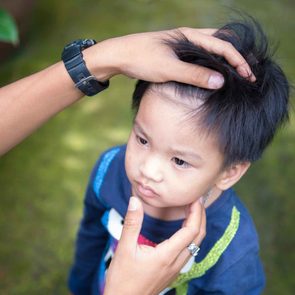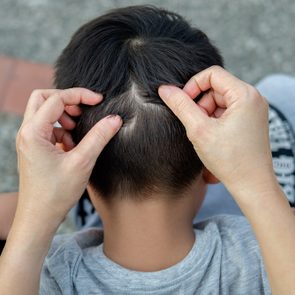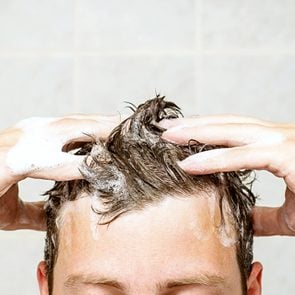A Guide to Head Lice Symptoms and Treatments
Updated: Nov. 04, 2020
Is the itchiness on your scalp from dandruff or lice? Here's how to tell if your symptoms could be head lice, and how you can treat and prevent lice infestations.
On This Page
What are lice?
The itchiness, irritation, and the incessant scratching caused by the small bugs on your scalp and hair make head lice a nuisance at best and at worst, well—they’re the worst.
Head lice feed on blood several times each day and tend to reside close to your scalp, which explains the itchiness and why it’s sometimes so difficult to tell that you have head lice. And they are notoriously difficult to get rid of—if you leave even one tiny egg behind on a single hair it can give rise to a renewed infestation.
Yet, there is a bit of good news—a head lice infestation is not known to spread disease. (Although they can have a serious mental health impact from repeated treatments, obsessive hair combing, and worrying about them.)
Lice, the plural of louse, are from the insect group known as Psocodea and are ectoparasites, which means that they are bugs that feed off of human blood. Unlike other parasites, lice live outside of your body, explains Brittany Smirnov, DO, a dermatologist in Delray, Florida.
Head lice are one type of lice, but there are others too. Body lice are known as Pediculus humanus corporis, and pubic lice are called Pthirus pubis. Only the body louse spreads disease.
To fully understand how to spot, prevent, and treat lice, you must understand their life cycle, which has three stages: egg, nymph, and adult.
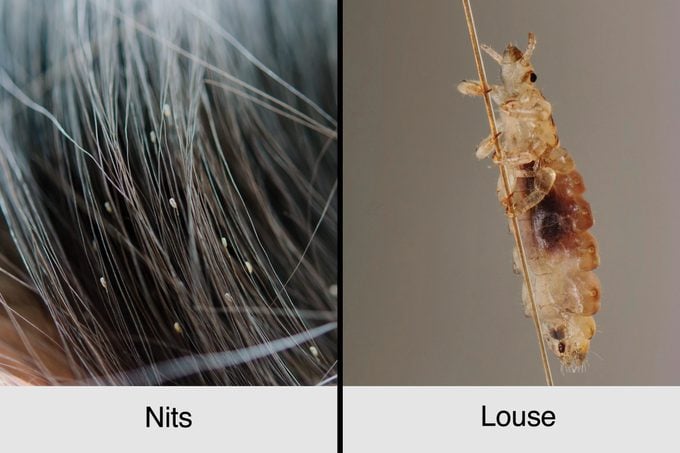
What do lice look like?
An adult louse is about the size of a sesame seed. With six legs, these tan to grayish-white critters get around by crawling. Fortunately, lice can’t fly or jump. Adult lice can live up to 30 days on your head as long as there is blood for them to feast on. If the louse falls off, it will die within two days without food.
Female lice are larger than their male counterparts and lay eggs (called nits) at the base of your hair shaft near your scalp. The nits are firmly attached to the hair shafts—essentially they are glued to your hair. A female louse may lay anywhere from three to five eggs per day, Dr. Smirnov says.
Nits are tiny, oval, and hard to see. They are yellow to white in color and may resemble dandruff to an untrained or unaware eye. How can you tell the difference between dandruff and lice nits? Dandruff can be easily brushed away, but a nit can’t be removed without actually pulling the tiny egg off the hair shaft.
Not all nits will hatch, but those that are most likely to hatch are the ones found very close to your scalp. It takes up to nine days for a nit to hatch into a baby louse, called a nymph. Nymphs are smaller than adult lice, but they mature only about a week after hatching. Like their adult counterparts, they need blood to survive.
Once the nit hatches, the empty egg casing can remain behind—so sometimes what looks like viable nits attached to the hair shaft are actually empty egg casings that can’t start a new infestation.
Head lice causes
Head lice is spread by head-to-head contact that may occur at home, school, parties, playdates, sports, or camp, Dr. Smirnov says.
“Sharing pillows, blankets, rugs, hairbrushes, hats, and even other clothing may also spread lice,” she says. Children in preschool and elementary school are more likely to catch lice because they tend to play in close quarters with each other.
“If your child has lice and rubs his or her head on a carpet, the lice can remain there for two days where they may find another scalp to attach to,” she explains.
A common head lice myth is that head lice are related to hygiene. Lice actually have a hard time holding on to dirty or greasy hair and are happy to infest perfectly clean, shiny hair.
Not everyone is at equal risk of lice. In the U.S., head lice is much less likely to occur in Blacks than people of other races, according to the Centers for Disease Control and Prevention. This is likely because the head lice most commonly found in the U.S. have claws that are better suited for grabbing the width and shape of some types of hair compared to others.
Head lice symptoms
Lice don’t always cause symptoms, particularly early on in the infestation. Most schools, daycare centers, and camps have lice checks at several points in the year to try to catch lice infestations early.
Sometimes you’ll get an email or note from school or camp letting you know that another child has lice, and you check your child’s hair and find that he or she has it too, says Alexandra Golant, MD, program director, dermatology residency, assistant professor, dermatology, Icahn School of Medicine at Mount Sinai, New York City.
That said, there may be some tickling or a sensation of movement on the scalp if your child has lice. Itching can occur—likely from the bites. This is triggered by an allergic reaction to the louse’s saliva, Dr. Golant says. Some people with lice also may have difficulty sleeping due to the itch, especially because lice are more active in the dark.
You or your child may develop sores from scratching at your scalp, and these can become infected. From there, you may get swollen lymph nodes in the neck because scratching can spread bacteria. (Here are more signs your child has lice.)
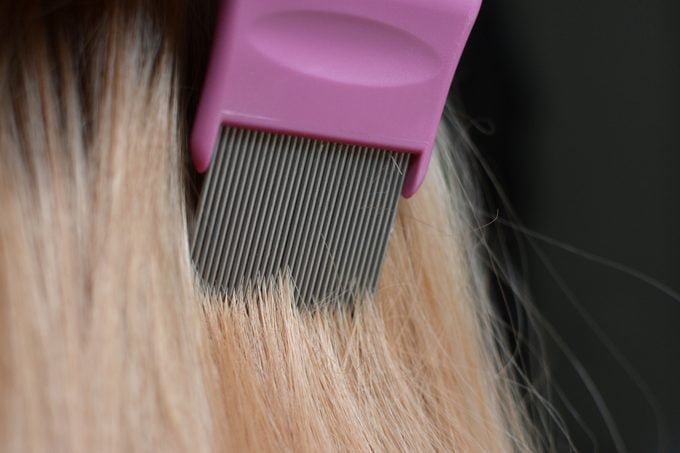
How to check for lice
Spotting a live louse in your hair or on your scalp is the best indication of an infestation. These creepy critters are not easy to find because they are small, fast, and tend to avoid light. Nits can be found more easily on hair behind the ears and near the back of the neck.
To check for lice, use a fine-toothed or special lice comb and separate your child’s wet hair into sections. Start at the scalp and comb through each section to look for lice or nits, suggests the American Academy of Dermatology (AAD). Wipe the comb on a wet paper towel and examine it carefully.
It also makes sense to inspect household items and any clothing that your child has worn for the past two days. Machine wash these items in hot water and dry them at a high temperature to kill the lice.
If one person in a household has lice, everyone else who lives there should be checked because the lice spread from person-to-person so easily. It’s also important that you let your child’s school, daycare, or babysitter know about the lice so that they can take the necessary precautions, as well as check themselves or other children for signs of lice.
Sometimes, wet-combing your child’s hair to remove the lice and nits is all that you need to do to treat a lice infestation. “It is time-consuming and can be hard to do if the child with lice is young,” Dr. Golant notes.
Head lice treatment
There are over-the-counter (OTC) medications and home remedies available to treat lice, but it’s a good idea to talk to your doctor if they aren’t working.
“If the lice isn’t going away and you treated it at least twice, go see a dermatologist,” says Michele Green, MD, a dermatologist at Lenox Hill Hospital in New York City.
It may be time to use prescription medication or it’s possible that the problem is something other than lice such as scabies (an intensely itchy skin condition caused by microscopic mites) or bed bugs, she says. (Here are 20 more reasons for an itchy scalp besides lice.)
OTC medication
A treatment that kills lice is known as a pediculicide, and one that kills their eggs is an ovicide.
Available products differ largely based on the active ingredient and whether or not they also kill nits. Most OTC head lice treatments don’t kill nits, Dr. Smirnov says. That means you generally need to treat people twice—once to kill the adult lice and then a second time, about 9 days later, to kill the lice that hatched from the nits since the last treatment.
“You will need to be treated at least twice with available OTC treatments,” Dr. Smirnov says.
In general, OTC lice products contain pyrethrin, which is found in chrysanthemum flowers and is toxic to lice. (Pyrethrin-based products also kill fleas.) It’s important to follow the instructions on the product label carefully so it is safe and has the best chance of doing its job. For example, conditioners can act as a barrier that keeps the head lice medicine from working.
It’s important to wait two days to wash your hair after treatment so the medication has ample time to work. You should also comb through the hair with the special lice comb once a day. The AAD suggests keeping the combing up for two to three weeks to make sure you get every last louse and nit. These same steps should be taken after the second treatment too.
It’s an arduous process to comb lice and nits from hair each day, and there are professional services available like LiceEnders that do all of it for you—at a cost. Some lice removal professionals make house calls as well.
Making matters worse, there have been reports that lice are becoming resistant to ingredients found in OTC lice-killing shampoos and cream rinses because they have been used for so many years. This means they may not work anymore, Dr. Smirnov notes. (Find out if tea tree oil for lice works.)
Prescription medications
Prescription lice treatments contain different active ingredients than OTC shampoos and cream rinses. These lice medications include:
- Benzyl alcohol lotion (Ulesfia), 5 percent, kills lice, but not nits. Retreatment is needed in one week. This lotion may irritate the scalp.
- Ivermectin lotion (Sklice), 0.5 percent, kills lice and may prevent nymphs from maturing. “One application on dry hair is usually all that is needed, and there is no wet combing necessary with ivermectin lotion,” says Dr. Golant. While not specifically approved for lice, ivermectin pills may also be effective. Some doctors will use these off label to treat a lice outbreak, she adds.
- Malathion lotion (Ovide), 0.5 percent, kills lice and may also kill some nits. “Malathion lotion can be highly effective,” says Dr. Golant.” In some cases, a single application is sufficient, but we will often have patients reapply to catch any eggs that may not have hatched,” she says. It is highly flammable so it’s important to take precautions and keep it away from any flames, she notes.
- Spinosad topical suspension (Natroba), 0.9 percent, kills live lice only. One treatment is usually enough.
The itching can be treated with topical corticosteroids along with any of these medications, Dr. Golant says.
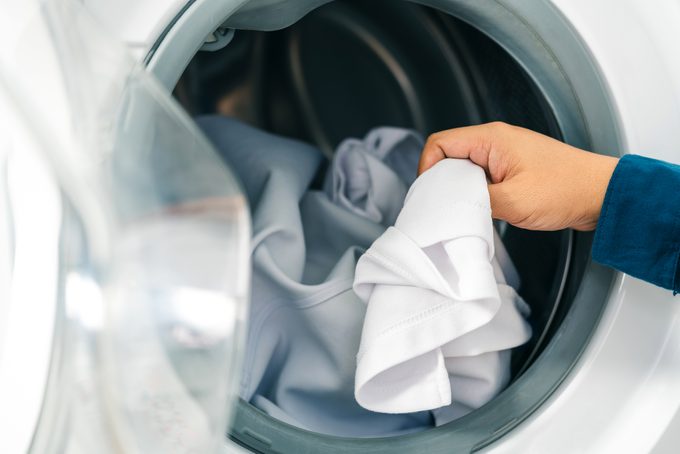
Home remedies for lice
Most dermatologists caution against the use of home remedies for lice such as mayonnaise, hair gel, petroleum jelly, butter, or olive oil, which are slathered on the scalp and hair and left on overnight to suffocate the lice. “Lice are difficult to suffocate,” Dr. Golant says. She adds, “Wet combing is a less messy and more effective way to kill lice if you want to avoid insecticides.”
If you do try home remedies like these, two treatments are usually required as well, since they won’t kill nits. (Here’s what you should know about using tea tree oil for lice.)
It’s also important to get rid of lice in your home and on any clothing, Dr. Smirnov says. High heat kills lice. “Wash any sheets, pillowcases, or clothing in hot water and run the dryer at higher than 130 degrees F,” she says. “You can also place the objects in the dryer and run it for five minutes or more at 130 F or higher to kill lice.”
Alternatively, she says, you can place the possibly infected items in a plastic bag and tie it closed. “Keep it out of use for two weeks to be safe.”
She also suggests vacuuming the couch and other areas where they lice may lurk and avoiding that space for 48 hours. The Centers for Disease Control and Prevention (CDC) cautions against using fumigant sprays and fogs to get rid of lice in the home, as these can be toxic if inhaled or absorbed through the skin.
Where do lice come from?
There are things to do to reduce the chances of head lice infestations affecting your child and your home. Head lice spread from person to person, so make sure no one shares hairbrushes, combs, hats, scarves, coats or hair accessories, and avoid head-to-head contact. (These are some of the surprising ways you can catch head lice.)
Making sure to check and re-check children for lice after they have been exposed and treated also can prevent spread.
Kids can return to school after treatment has begun. The American Academy of Pediatrics and the National Association of School Nurses are against “no-nit” policies that would require a child to be free of nits before returning to school.
The reason for this is that most nits are unlikely to hatch once treatment has started, and this policy will cause unnecessary and prolonged absences from school.
Helpful products
Getting rid of head lice is a lot easer if you have the right tools. Here are some things you can buy that may help combat lice.
- 10 Products That Help You Get Rid of Head Lice
- Is Tea Tree Oil Really a Treatment for Lice?
- 10 Home Remedies for Lice That May Really Work
Additional resources
If you need additional help with head lice, here are some foundations, government organizations, and medical societies that can offer assistance.


